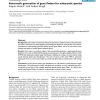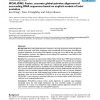1964 search results - page 84 / 393 » An analysis of extensible modelling for functional genomics ... |
BMCBI
2006
14 years 10 months ago
2006
Background: The number of sequenced eukaryotic genomes is rapidly increasing. This means that over time it will be hard to keep supplying customised gene finders for each genome. ...
BMCBI
2006
14 years 10 months ago
2006
Background: Non-coding DNA sequences comprise a very large proportion of the total genomic content of mammals, most other vertebrates, many invertebrates, and most plants. Unravel...
ICIP
2010
IEEE
14 years 7 months ago
2010
IEEE
The process of finding representative shape patterns from sparse datasets is a challenging task: especially for non-rigid objects, shape deformations through time can produce very...
BMCBI
2008
14 years 10 months ago
2008
Background: A primary reason for using two-color microarrays is that the use of two samples labeled with different dyes on the same slide, that bind to probes on the same spot, is...
BMCBI
2006
14 years 10 months ago
2006
Background: Array-based comparative genome hybridization (aCGH) is a tool for rapid comparison of genomes from different bacterial strains. The purpose of such analysis is to dete...


